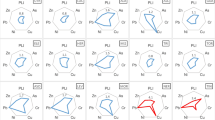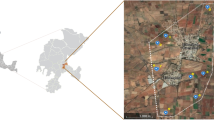Abstract
Large uranium accumulations in vegetable foodstuffs may present risks of human health if they are consumed. The objective of this study was to evaluate the uranium concentrations in different vegetable foodstuffs and grown in agricultural soils, which are then consumed by the residents of the village of Cunha Baixa (Portugal),—located in an former uranium mining area. This study was conducted to address concerns expressed by the local farmers as well as to provide data for uranium-related health risk assessments for the area. Soils, irrigation water and edible tissues of lettuce, potato, green bean, carrot, cabbage, apple and maize (Latuca sativa L., Solanum tuberosum L., Phaseolus vulgaris L., Daucus carota L., Brassica oleracea L., Malus domestica Borkh, Zea mays L., respectively) were sampled and uranium determined. High uranium concentrations were found in some soils (Utotal > 50 mg/kg), in irrigation waters (218 to 1,035 μg/l) and in some vegetable foodstuffs (up to 234, 110, 30, 26, 22, 16 and 1.6 μg/kg fresh weight for lettuce, potato with peel, green bean pods, cabbage, corn, carrot and apple, respectively). However, the results of the toxicity hazard analysis were reassuring the estimated level of uranium exposure through the ingestion of these vegetable foodstuffs was low, suggesting no chemical health risk (hazard quotient <1) to this uranium exposure pathway for a local residents during their lifetime, even for the most sensitive part of the population (child).


Similar content being viewed by others
References
Actlabs, Activation Laboratories Ltd. (2009). http:/www.actalabsint.com. Accessed 4 Dec 2009.
Amrhein, C., Mosher, P. A., & Brown, A. D. (1993). The effects of redox on Mo, U, B, V, and As solubility in evaporation ponds. Soil Science, 155(4), 249–255.
Anke, M., Seeber, O., Müller, R., Schäfer, U., & Zerull, J. (2009). Uranium transfer in the food chain from soil to plants, animals and man. Chemie Erde-Geochemistry, 69, 75–90.
ANZECC, Australian and New Zealand Environment and Conservation Council. (2000). Water quality guidelines. Quality for irrigation and general uses. http://www.mfe.govt.nz/publications/water/anzecc-water-quality-guide-02/anzecc-water-quality-guide-02-pdfs.html. Accessed 7 March 2010.
Araújo, M. F., Barbosa, T., Madruga, M. J., & Faria, I. (2001). Dispersão de contaminantes e sua transferência no sistema solo-planta nas escombreiras da mina de urânio da Urgeiriça (pp. 567–573). Beja: Actas Congresso Internacional Sobre Património Geológico e Mineiro.
Bearman, P. J. (1979). A review of the environmental problems associated with the disposal of uranium tailings. Environmental Geochemistry and Health, 1(2), 64–74.
Carta de Solos. (1978). Unidades Pedológicas segundo o esquema da FAO para a Carta dos Solos da Europa (escala 1:1000 000). Portugal: Atlas de Ambiente, Comissão Nacional do Ambiente.
CCME, Canadian Council of Ministers of the Environment. (2007). Canadian soil quality guidelines for uranium: environmental and human health. Scientific supporting document. CCME, Winnipeg. http://www.ccme.ca/assets/pdf/uranium_ssd_soil_1.2.pdf. Accessed 25 January 2010.
Choudhury, S., Boruah, M., & Goswami, T. D. (1992). Estimation of uranium in some edible and commercial plants. Defense Science Journal, 42(4), 241–243.
DL, Decree Law 236/98, Portuguese Legislation on Water Quality, DR nº 176/98, annexes XVI and XXI.
Domingo, J. L., Paternain, J. M., Llobet, J. M., & Corbella, J. (1989). The developmental toxicity of uranium in mice. Toxicology, 55, 143–152.
Dushenkov, S., Vasudev, D., Kapulnik, Y., Gleba, D., Fleisher, D., Ting, K. C., et al. (1997). Removal of uranium from water using terrestrial plants. Environmental Science Technology, 31(12), 3468–34574.
EFSA, European Food Safety Authority. (2009). Scientific Opinion of the Panel on Contaminants in the Food Chain on a requested from German Federal Institute for Risk Assessment (BfR) on uranium in foodstuff, in particular mineral water. EFSA Journal, 1018, 1–59.
Ferreira, M. J. S. (2007). Toxicidade de solos uraníferos em cogumelos e plantas comestíveis. MSc Dissertation, University of Aveiro, Portugal.
Gilman, A. P., Moss, M. A., Villeneuve, D. C., Secours, V. E., Yagminas, A. P., Tracy, B. L., et al. (1998). Uranyl nitrate: 91-day exposure and recovery studies in the male New Zealand white rabbit. Toxicological Sciences, 41, 138–151.
Huang, J. W., Blaylock, M. J., Kapulnik, Y., & Densley, B. D. (1998). Phytoremediation of uranium-contaminated soils: Role of organic acids in triggering uranium hyperaccumulation in plants. Environmental Science and Technology, 32, 2004–2008.
IRIS, Integrated Risk Information System. (2008). Uranium, soluble salts. http://www.epa.gov/iris/subst/o421.htm. Accessed 18 Oct 2008.
Jones, R. L. (1992). Uranium and phosphorous contents in Morrow plot soils over 82 years. Communications Soil Science Plant Analysis, 23(1–2), 67–73.
Kurttio, P., Auvinen, A., Salonen, L., Saha, H., Pekkanen, J., Mäkeläinen, I., et al. (2002). Renal effects of uranium in drinking water. Environmental Health Perspective, 110, 337–342.
Kurttio, P., Komulainen, H., Leino, A., Salonen, L., Auvinen, A., & Saha, H. (2005). Bone as possible target of chemical toxicity of natural uranium in drinking water. Environmental Health Perspective, 113, 68–72.
Lakshmanan, A. R., & Venkateswarlu, K. S. (1988). Uptake of uranium by vegetables and rice. Water Air Soil Pollution, 38, 151–155.
Neves, O. (2002). Minas desactivadas e impactos geoquímicos ambientais. O caso da mina de urânio da Cunha Baixa (Viseu). Ph.D. Dissertation, Technical University of Lisbon, Portugal.
Neves, O., Abreu, M. M., & Matias, M. J. (2003). Uranium, aluminium and manganese behaviour in maize grown in soils of uranium Cunha Baixa mine–site. Memórias e Notícias, 2(Nova Série), 265–278.
Neves, O., Abreu, M. M., & Matias, M. J. (2009). Uranium distribution in the solid phases of soils from Cunha Baixa mining site (Portugal). Revista de Ciências Agrárias, XXXI(1), 195–204.
Neves, O., Abreu, M. M., & Vicente, E. M. (2008). Uptake of uranium by lettuce (Lactuca sativa L.) in natural uranium contaminated soils in order to assess chemical risk for consumers. Water Air Soil Pollution, 195, 73–84.
Neves, O., & Matias, M. J. (2008). Assessment of groundwater quality and contamination problems ascribed to an abandoned uranium mine (Cunha Baixa region, Central Portugal). Environmental Geology, 53(8), 1799–1810.
Póvoas, I., & Barral, M. F. (1992). Métodos de análise de Solos. Comunicações Instituto de Investigação Científica Tropical. Série Ciências Agrárias, 10, 41–61.
Santos Oliveira, J. M., & Ávila, P. F. (2001). Geoquímica na área envolvente da mina da Cunha Baixa (Mangualde, no centro de Portugal). Estudos, Notas e Trabalhos, 43, 25–47.
Schollenberger, C. J., & Simon, R. H. (1945). Determination of exchange capacity and exchangeable bases in soil-ammonium acetate method. Soil Science, 59, 13–24.
Shahandeh, H., & Hossner, L. (2002). Role of soil properties in phytoaccumulation of uranium. Water Air Soil Pollution, 141, 165–180.
Shtangeeva, I. (2008). Uptake of uranium and thorium by native and cultivated plants. Journal Environmental Radioactivity, 101(6), 458–463.
Takeda, A., Tsukada, H., Takaku, Y., Hisamatsu, S., & Nanzyo, M. (2006). Accumulation of uranium derived from long-term fertilizer application in a cultivated Andisol. Science Total Environment, 367(2–3), 924–931.
USEPA, US Environmental Protection Agency. (1997). Exposure factors handbook. EPS/600/P-95/002Fa, Vol. 1. US Environmental Protection Agency. Washington, DC. http://www.epa.gov/ncea/pdfs/efh/front.pdf. Accessed 5 April 2007.
USEPA, US Environmental Protection Agency. (2000). Handbook for non-cancer health effects evaluation. US Environmental Protection Agency.Washington, DC. http://www.epa.gov/osa/spc/noncancer.htm. Accessed 5 April 2007.
WHO, World Health Organization. (2001) Depleted uranium: sources, exposure and health effects. Department of Protection of the Human Environment. WHO/SDE/PHE/01.1. http://www.who.int/ionizing_radiation/en/du/en. Accessed 10 Dec 2009.
WHO, World Health Organization. (2005). Uranium in drinking water. background document for development of WHO guidelines for drinking water quality. WHO/SDE/03.04/118. http://www.who.int/water_sanitation_health/dwq/chemicals/uranium/en. Accessed 10 Dec 2009.
Zamora, M. L., Tracy, B. L., Zielinski, J. M., Meyerhof, D. P., & Moss, M. A. (1998). Chronic ingestion of uranium in drinking water: a study of kidney bioeffects in humans. Toxicological Sciences, 43, 395–398.
Acknowledgments
This work has been supported by the Program POCI 2010 and FEDER European Communitarian Funds (Research Project POCI/ECM/59188/2004) and by the Centre of Petrology and Geochemistry of Technical University of Lisbon (Portugal).
Author information
Authors and Affiliations
Corresponding author
Rights and permissions
About this article
Cite this article
Neves, M.O., Abreu, M.M. & Figueiredo, V. Uranium in vegetable foodstuffs: should residents near the Cunha Baixa uranium mine site (Central Northern Portugal) be concerned?. Environ Geochem Health 34, 181–189 (2012). https://doi.org/10.1007/s10653-011-9428-9
Received:
Accepted:
Published:
Issue Date:
DOI: https://doi.org/10.1007/s10653-011-9428-9




